
When most people think of Wisconsin, they think of cheese, beer, or sports teams like the Green Bay Packers. However, The Badger State also has a rich natural history, as evidenced by its common nickname. You can find many kinds of plants and animals throughout the state, including bald eagles and bigmouth buffalo. Wisconsin is also home to many common and unique species of spiders ranging from orb weavers to wolf spiders. Here is a list of 10 spiders in Wisconsin that you can find scattered throughout the state.
#10. Giant Lichen Orb Weaver
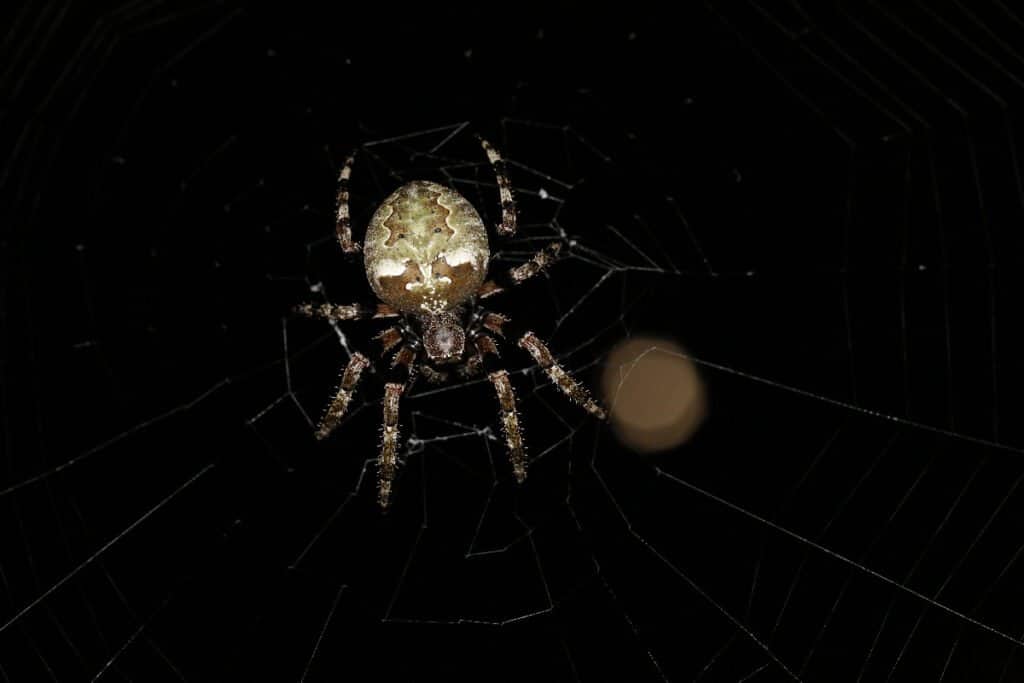
The giant lichen orb weaver creates webs nearly 8 feet wide
©Cathleen Wake Gorbatenko/Shutterstock.com
The giant lichen orb weaver, Araneus bicentenarius, belongs to the orb weaver family Araneidae. It ranges throughout most of the central and eastern United States and parts of Canada.
Giant lichen orb weavers rank as one of the largest orb weaver spiders in Wisconsin. Adult specimens can reach up to 24 millimeters long, with females typically measuring larger than males. The legs look black with orange rings, and the body appears greyish-green with white and dark markings. However, they can also sometimes look yellow. Sometimes people mistake them for European garden spiders, but giant lichen orb weavers lack a cross-shaped marking on the abdomen.
Giant lichen orb weavers make radial-style webs that can reach up to 8 feet in diameter, hence their name. Their bite is not medically significant despite their large size. Common symptoms include mild pain and redness.
#9. Northern Black Widow
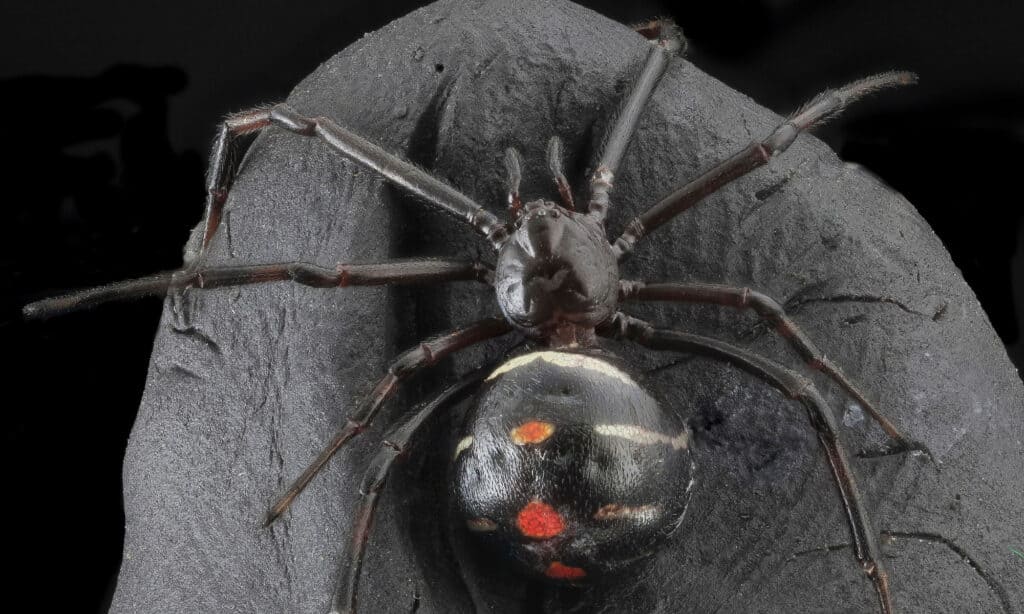
Unlike other black widows, northern black widows have a broken hourglass-shaped marking on their abdomens.
©Porco_Rosso/Shutterstock.com
Latrodectus variolus is more commonly known as the northern black widow. A member of the cobweb spider family Theridiidae, it is widely distributed throughout the northern and eastern United States and Canada.
Female northern black widows range from 9 to 11 millimeters long, and males measure between 4 and 5 millimeters long. Like most black widows, they look primarily black aside from a red hourglass-shaped marking on the abdomen. However, the hourglass marking usually does not look intact. This distinction can help you differentiate them from other black widows.
Northern black widows rank as one of the most dangerous spiders in Wisconsin due to their potent venom. Their venom carries neurotoxins capable of causing latrodectism. Symptoms from bites commonly include pain, sweating, vomiting, and muscle rigidity. Bites normally don’t prove fatal, but you should still seek medical attention as soon as possible.
#8. Striped Fishing Spider
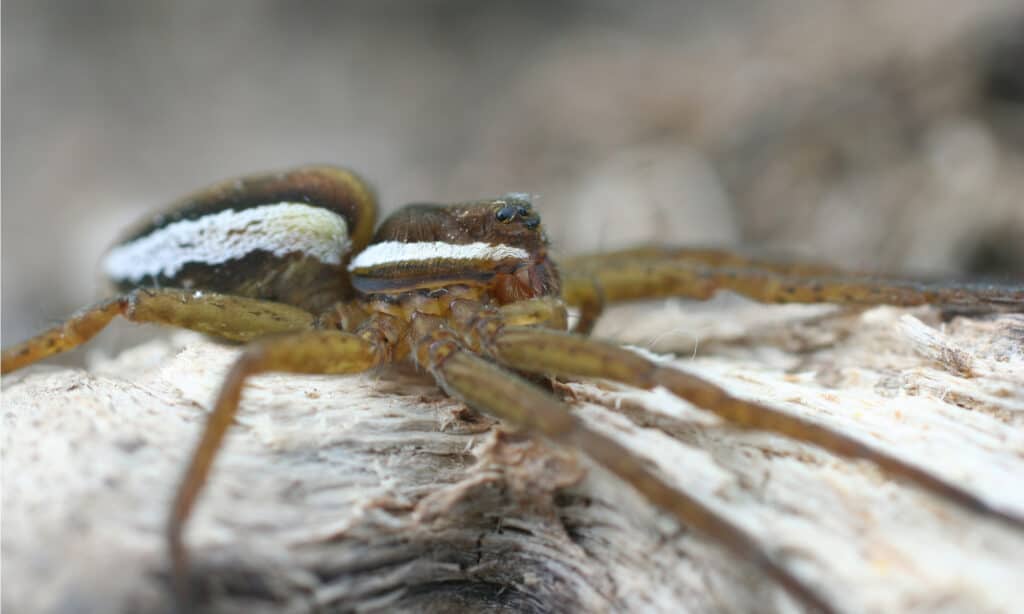
The striped fishing spider catches prey using its legs as fishing lures or by running on top of the water.
©Oleg Nikonov/Shutterstock.com
The striped fishing spider, Dolomedes scriptus, is a member of the fishing spider family Pisauridae. You can find these spiders in Wisconsin and throughout much of the United States and Canada.
Female striped fishing spiders can reach up to 25 millimeters long, while males measure significantly smaller. They usually look mostly light brown in color but can vary between grey and tan. The abdomen features a dark W-shaped marking, and they also sport a thick white or tan stripe down each side.
Striped fishing spiders tend to live near bodies of water such as streams, ponds, or lakes. As their name implies, they don’t use webs to capture their prey. Instead, they use speed and stealth to snatch insects and small fish from the water and vegetation. They can also dive under the water or run across its surface for short distances.
#7. Black-Footed Yellow Sac Spider
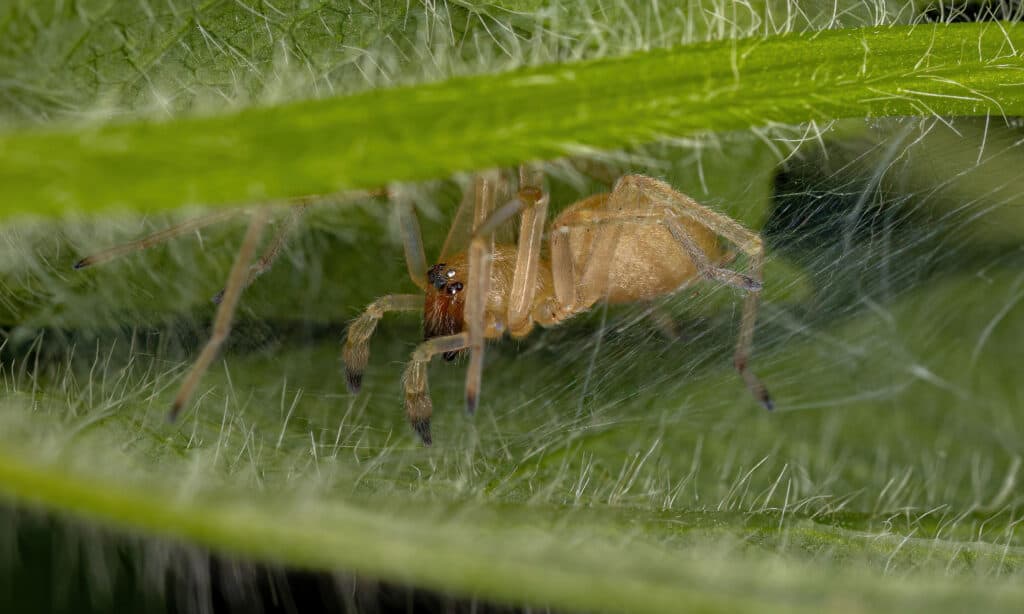
The black-footed
yellow sac spider
builds a silk sac to protect itself from predators during the day
©iStock.com/ViniSouza128
Cheiracanthium inclusum, or the black-footed yellow sac spider, belongs to the family Cheiracanthiidae. It also goes by the name the American yellow sac spider and ranges throughout South and North America.
Adult females typically measure between 5 and 9 millimeters long, while males measure from 4 to 8 millimeters long. They feature dark markings near the ends of the jaws and feet, which is where they get their name. Otherwise, they look predominantly pale yellow. The abdomen sometimes sports an orange-brown stripe down the center, but not always.
Blacked-footed yellow sac spiders actively hunt for food instead of using webs to catch their prey. They hunt at night and hide in silken shelters during the day to avoid predators. You can often find them climbing up a single silk strand, which they sometimes ride like a balloon in the wind.
#6. Giant House Spider
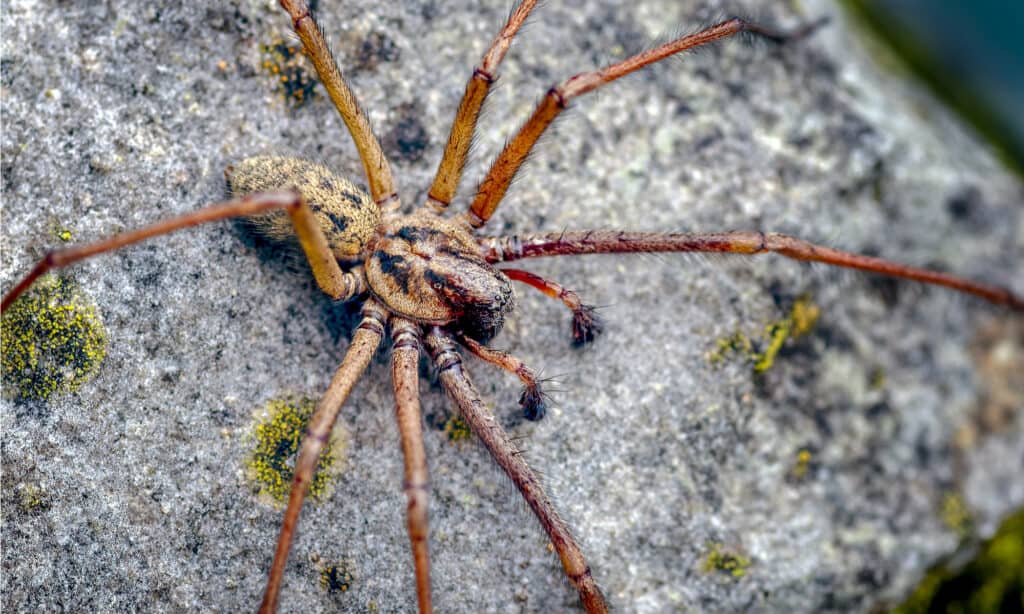
Giant House Spider
©R K Hill/Shutterstock.com
The term giant house spider actually refers to three different species; Eratigena atrica, E. duellica, and E. saeva. All three spiders belong to the funnel weaver family Agelenidae. Although mostly found in Europe, you can also find these spiders in Wisconsin and throughout the United States.
Female giant house spiders can grow up to 18.5 millimeters long. Meanwhile, males generally measure between 12 and 15 millimeters long. In terms of appearance, they vaguely resemble common house spiders. They look predominantly brown except for 3 light spots on each side that form the shape of a forward-facing arrow. The abdomen, legs, and palps all measure quite large, hence their name.
Giant house spiders make messy funnel webs made of non-sticky silk. They hunt by ambushing insects that wander in or near their webs. Their bite is not medically significant despite their large size.
#5. White-Banded Crab Spider

The white-banded crab spider ambushes its prey.
©Georgi Baird/Shutterstock.com
Misumenoides formosipes, or the white-banded crab spider, is a member of the crab spider family Thomisidae. It is one of the most common crab spiders in Wisconsin and is widely distributed throughout the United States.
Female white-banded crab spiders measure from 5 to 11 millimeters long, and males measure between 2.5 and 3.2 millimeters long. Specimens vary in color, with females typically looking yellow or white while males look dark brown with a gold abdomen. They get their name from the distinctive white line that runs through the space below their eyes.
White-banded crab spiders are active hunters that use ambush tactics to capture their prey. Their favorite tactic involves waiting on the petals or leaves of flowers and grabbing pollinating insects with their powerful legs. Like other crab spiders, they can walk forward, sideways, and backward like a crab, hence their name.
#4. Hammock Spider

The hammock spider makes a hammock-shaped web.
©Moni.ka/Shutterstock.com
The hammock spider, Pityohyphantes costatus, is a member of the sheetweb spider family Linyphiidae. You can find these tiny spiders in Wisconsin and throughout much of the United States.
Adult hammock spiders range between 3.6 and 7 millimeters long, with males generally measuring smaller than females. The legs and carapace look primarily grey-brown or light beige. Meanwhile, the abdomen appears light brown with a dark brown patch in the middle and white spots along the sides. Additionally, a dark brown or black line runs down the middle of the carapace.
Hammock spiders get their name from the hammock-shaped webs they make and use to catch their prey. They build their webs in shrubs or on tree branches and wait nearby for prey to wander into the silk hammock. Their bite is not medically significant due to their small size.
#3. Tan Jumping Spider
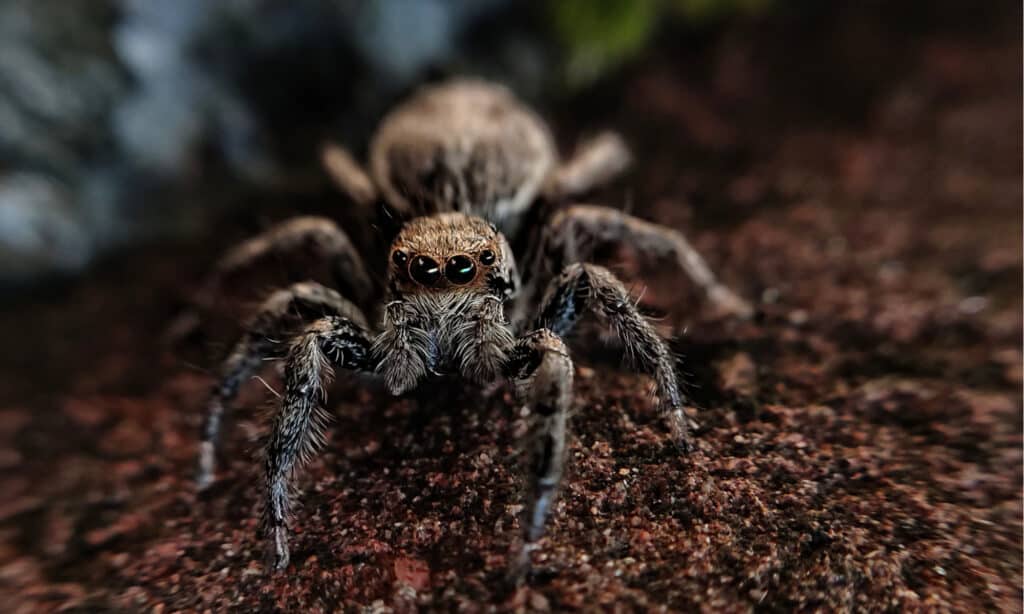
Tan jumping spider close up shot showing round eyes and furry body
©SwastikEs/Shutterstock.com
Platycryptus undatus, or the tan jumping spider, belongs to the jumping spider family Salticidae. It is one of the more common jumping spiders in Wisconsin and ranges throughout North and Central America.
Adult females range from 10 to 13 millimeters long, and males measure between 8.5 and 9.5 millimeters long. The body looks predominantly brown, grey, or tan, hence their name. They also feature distinctive light grey or beige V-shaped markings along the length of the abdomen.
Like other members of their family, tan jumping spiders do not use webs to catch their prey. Instead, they use their keen eyesight and quick reflexes to catch small insects by leaping on their prey from a distance. They normally run away from people but will bite if threatened and cornered. Due to their small size, their bite is not medically significant.
#2. Feather-Legged Orb Weaver
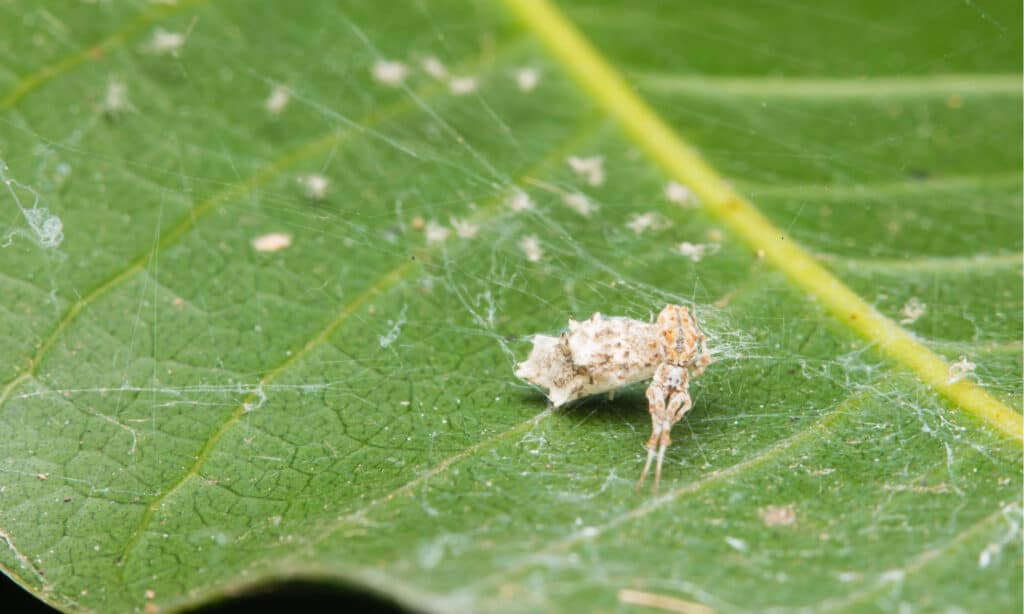
A feather-legged orb weaver spider keeping its eggs sac/uloborus plumipes
©Somyot Mali-ngam/Shutterstock.com
The feather-legged orb weaver, Uloborus glomosus, is a member of the cribellate orb weaver family Uloboridae. While it is the only member of its family in North America, it’s one of many orb weaver spiders in Wisconsin.
Adult feather-legged orb weavers range from 3 to 10 millimeters long, although males tend to measure smaller than females. They possess long, thick legs covered in feathery hairs, hence their name. The body appears primarily light orangish-brown. Meanwhile, the large abdomen features distinctive bumps along its upper half.
Unlike most spiders, feather-legged orb weavers do not possess venom glands. They developed a hunting method that involves wrapping their prey in wooly silk located in the spinneret. While not sticky like the thread of some spiders, the wooly texture efficiently traps prey long enough for the spider to wrap up and immobilize its prey.
#1. Wetland Giant Wolf Spider

You can often find wetland giant wolf spiders in marshes or fields close to water.
©Judy Gallagher / Creative Commons – License
Tigrosa helluo, or the wetland giant wolf spider, belongs to the wolf spider family Lycosidae. It ranges throughout the eastern United States and is one of several wolf spiders in Wisconsin.
Adult wetland giant wolf spiders typically measure about 17 millimeters long, with females measuring larger than males on average. The abdomen and carapace and abdomen appear predominantly brown except for a characteristic yellow stripe down the middle of the cephalothorax. They also sport several dark spots on the ventral side of the abdomen.
You can most often find wetland giant wolf spiders in forests, fields, and marshes near freshwater, hence their name. They actively hunt for prey using their strength, speed, and stealth instead of relying on webs to trap their food. Their bite is not threatening to humans, and they rarely attack humans.
Summary Of 10 Spiders In Wisconsin
| Rank | Spider |
|---|---|
| 10 | Giant Lichen Orb Weaver |
| 9 | Northern Black Widow |
| 8 | Striped Fishing Spider |
| 7 | Black-Footed Yellow Sac Spider |
| 6 | Giant House Spider |
| 5 | White-Banded Crab Spider |
| 4 | Hammock Spider |
| 3 | Tan Jumping Spider |
| 2 | Feather-Legged Orb Weaver |
| 1 | Wetland Giant Wolf Spider |
The photo featured at the top of this post is © Judy Gallagher / Creative Commons – License / Original
Thank you for reading! Have some feedback for us? Contact the AZ Animals editorial team.






